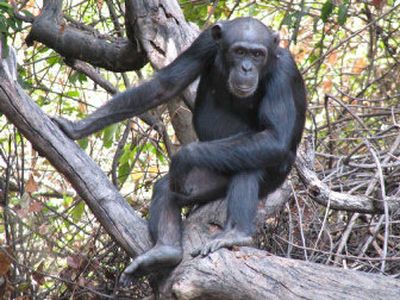Chimps found making spears

Chimpanzees living in the West African savannah have been observed fashioning deadly spears from sticks and using the hand-crafted tools to hunt small mammals – the first routine production of deadly weapons ever observed in animals other than humans.
The multistep, spear-making practice, documented by researchers in Senegal who spent years gaining the chimpanzees’ trust, adds credence to the idea that human forebears fashioned similar tools millions of years ago.
The landmark observation also supports the long-debated proposition that females – the main makers and users of spears among the Senegalese chimps – tend to be the innovators and creative problem solvers in primate culture.
Using their hands and teeth, the chimpanzees were repeatedly seen tearing the side branches off long straight sticks, peeling back the bark and sharpening one end, the researchers report in Thursday’s online issue of the journal Current Biology. Then, grasping the weapon in a “power grip,” they jabbed into tree-branch hollows where bush babies – small monkey-like mammals – sleep during the day.
After stabbing their prey repeatedly, they removed the injured or dead animal and ate it.
“It was really alarming how forceful it was,” said lead researcher Jill D. Pruetz, of Iowa State University in Ames, adding that it reminded her of the murderous shower scene in the Alfred Hitchcock movie “Psycho.” “It was kind of scary.”
The new observations are “stunning,” said Craig Stanford, a primatologist and professor of anthropology at the University of Southern California. “Really fashioning a weapon to get food – I’d say that’s a first for any non-human animal.”
Scientists have documented tool use among chimpanzees for several decades, but the tools have been simple and used to extract food rather than to kill for it.
Some chimpanzees slide thin sticks or leaf blades into termite mounds, for example, to fish for the tasty, crawling morsels. Others crumple leaves and use them like sponges to sop drinking water from tree hollows.
But while a few chimpanzees have been observed throwing rocks – perhaps with the goal of knocking prey unconscious, but perhaps simply as expressions of excitement – and a few others have been known to swing simple clubs, only people have been known to craft tools expressly to hunt prey.
Pruetz and co-worker Paco Bertolani, of the University of Cambridge, made the observations near Kedougou in southeastern Senegal. Unlike other chimpanzee sites currently under study, which are forested, this site is mostly open savannah. That environment is very much like the one in which early humans evolved and is distinct enough from other sites to expect differences in chimpanzee behaviors.
Pruetz recalled the first time she saw a member of the 35-member troop trimming leaves and side-branches off a branch it had broken off a tree.
“I just knew right away that she was making a tool,” Pruetz said, adding that she suspected – with some horror – what it was for, as well. But in that instance she was not able to follow the chimpanzee to see what she did with it.
Eventually the research duo documented 22 instances of spear-making and use, two-thirds of them involving females.
In a typical sequence, the animal first discovered a deep hollow suitable for bush babies, which are nocturnal and weigh about half a pound. Then the chimp would break off a nearby branch – on average about two feet long, but up to twice that length – trim it, sharpen it with its teeth, and poke it repeatedly into the hollow at a rate of about one or two jabs per second.
After every few jabs, the chimpanzee would sniff or lick the tip, as though testing to see whether it had caught anything.
In only one of 22 observations did a chimp get a bushbaby. But that is reasonably efficient, Pruetz said, compared to standard chimpanzee hunting practice, which involves chasing a monkey or other prey, grabbing it by the tail and then slamming its head against the ground.
Chimpanzee behavior is widely believed to offer a window on early human behavior, and many researchers have hoped that the animals – which are humans’ closest genetic cousins – might reveal something about the earliest use of wooden tools.
The discovery that some chimps today make wooden weapons supports the idea that early humans did too – perhaps as much as 5 million years ago – Stanford said.